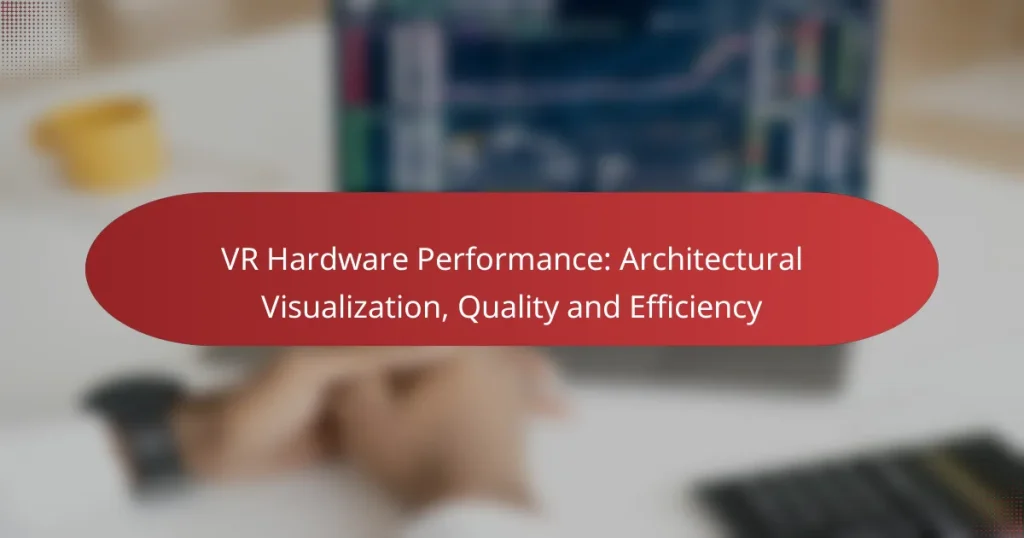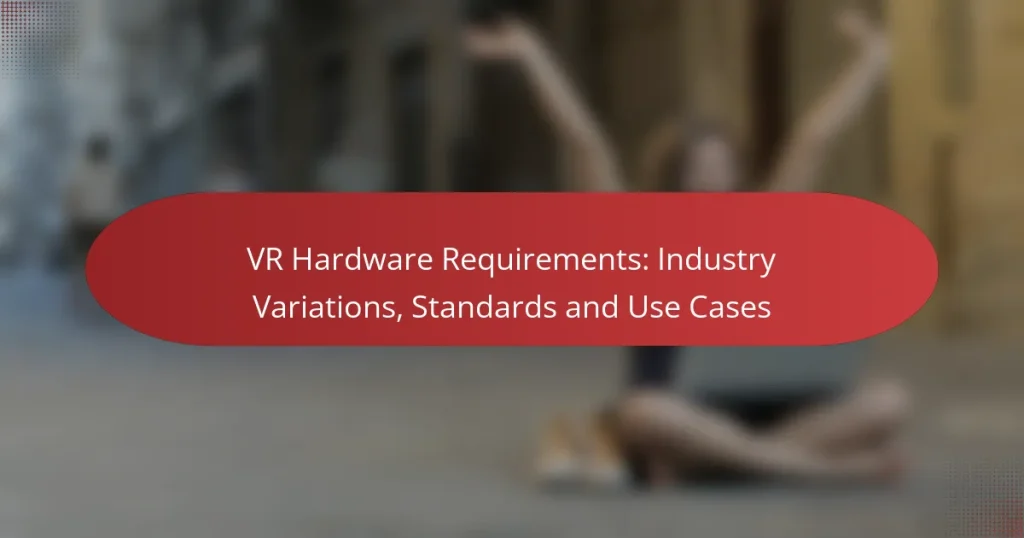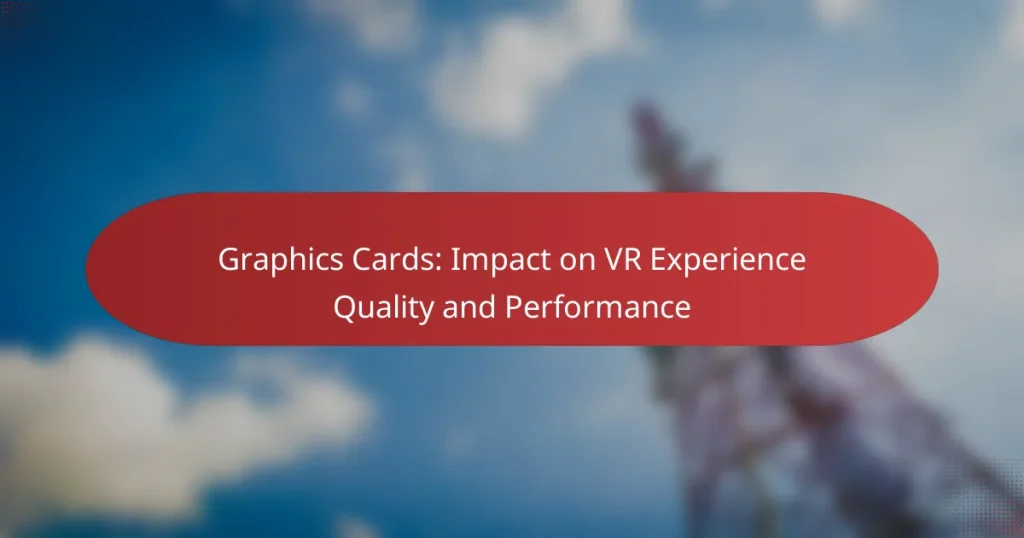Understanding the hardware requirements for virtual reality (VR) is essential for achieving an immersive experience. Key components include a compatible headset, a powerful computer or console, and adequate space for movement. Popular options in the UK, such as the Oculus Quest 2 and HTC Vive Pro, cater to various user needs, from casual gaming to professional use.
VR Hardware Performance: Architectural Visualization, Quality and Efficiency
VR Hardware Requirements: Industry Variations, Standards and Use Cases
Graphics Cards: Impact on VR Experience Quality and Performance
What are the hardware requirements for virtual reality in the UK?
The hardware requirements for virtual reality (VR) in the UK primarily include a compatible headset, a powerful computer or console, and sufficient space for movement. Users should ensure their systems meet the necessary specifications to achieve a smooth and immersive VR experience.
Minimum specifications for VR headsets
Minimum specifications for VR headsets typically include a resolution of at least 1080p, a refresh rate of 60 Hz, and a field of view around 90 degrees. These basic requirements allow users to experience VR but may result in lower visual quality and performance.
For example, headsets like the Oculus Quest 2 or PlayStation VR can operate within these minimum specifications, making them accessible options for beginners. However, users may encounter limitations in graphics and responsiveness.
Recommended specifications for optimal performance
For an optimal VR experience, recommended specifications include a resolution of 2160 x 1200 pixels, a refresh rate of 90 Hz or higher, and a field of view exceeding 100 degrees. These enhancements significantly improve clarity and immersion.
A powerful GPU, such as the NVIDIA GeForce RTX 3060 or AMD Radeon RX 6700 XT, is also advisable to handle demanding VR applications smoothly. Users should consider investing in high-quality headsets like the Valve Index or HTC Vive Pro for the best performance.
Additionally, ensure you have a minimum of 8 GB of RAM and a fast processor (Intel i5 or AMD Ryzen 5) to support the VR software effectively. This setup will help avoid lag and enhance the overall experience.
What VR headsets are available in the UK?
In the UK, popular VR headsets include the Oculus Quest 2 and the HTC Vive Pro, each offering distinct features and performance levels. These headsets cater to different user needs, from casual gaming to professional applications.
Oculus Quest 2 specifications
The Oculus Quest 2 is a standalone headset that does not require a PC or console, making it highly accessible. It features a resolution of 1832 x 1920 per eye and refresh rates up to 120 Hz, providing a smooth visual experience.
Key specifications include 6GB of RAM and storage options ranging from 64GB to 256GB. Its built-in battery lasts around 2-3 hours of active use, making it suitable for extended gaming sessions.
HTC Vive Pro specifications
The HTC Vive Pro is designed for high-end VR experiences and requires a powerful PC to operate. It boasts a resolution of 2880 x 1600 combined with a refresh rate of 90 Hz, delivering exceptional clarity and detail.
This headset includes 8GB of RAM and supports external sensors for room-scale tracking. The Vive Pro’s battery life is typically shorter than standalone headsets, often requiring a tethered connection for continuous use.
How to choose the right VR hardware?
Selecting the right VR hardware involves assessing your specific needs, whether for gaming or professional applications. Key factors include performance specifications, compatibility with existing systems, and budget considerations.
Factors to consider for gaming
For gaming, prioritize a high refresh rate, typically around 90 Hz or more, to ensure smooth visuals and reduce motion sickness. Graphics performance is crucial, so opt for a powerful GPU, ideally from the latest generations of NVIDIA or AMD.
Consider the resolution of the VR headset, as higher resolutions (like 1080p per eye) enhance immersion. Additionally, check for features like field of view and tracking capabilities, which can significantly impact your gaming experience.
Factors to consider for professional use
In professional settings, the choice of VR hardware should focus on precision and reliability. Look for headsets with high resolution and low latency to facilitate detailed work, such as design or simulations. A refresh rate of at least 90 Hz is also recommended to maintain a smooth user experience.
Compatibility with software applications is vital, so ensure that the hardware supports the specific programs you plan to use. Budget for additional accessories like motion controllers or external sensors, which can enhance functionality in professional environments.
What are the compatibility requirements for VR hardware?
Compatibility requirements for VR hardware primarily involve ensuring that your system meets the necessary specifications for optimal performance. This includes having the right operating system and a powerful graphics card to support immersive experiences.
Operating system compatibility
Most VR systems require a compatible operating system to function correctly. Commonly supported OS include Windows 10 or later, as many VR applications are optimized for this environment. Some VR headsets may also offer limited support for macOS, but this is less common.
Before purchasing VR hardware, check the manufacturer’s specifications for the required OS version. Keeping your operating system updated can also help improve performance and compatibility with new VR applications.
Graphics card requirements
The graphics card is a critical component for VR performance, as it directly impacts the visual quality and frame rates of VR experiences. Most VR setups recommend a dedicated graphics card from recent generations, such as NVIDIA’s GTX 1060 or AMD’s RX 480 as a minimum baseline.
For a smoother experience, especially in demanding applications, consider higher-end models like the NVIDIA RTX 3060 or AMD RX 6800. Ensure that your graphics card has sufficient VRAM (at least 6GB) to handle the high-resolution graphics typical in VR environments.
What are the future trends in VR hardware?
Future trends in VR hardware focus on enhanced immersion, improved performance, and greater accessibility. Key developments include advancements in wireless technology, lighter headsets, and the emergence of new brands offering competitive products.
Advancements in wireless technology
Wireless technology is rapidly evolving, making VR experiences more seamless and immersive. Innovations like Wi-Fi 6 and low-latency protocols enable high-quality streaming without the clutter of cables, allowing users to move freely within virtual environments.
As these technologies mature, expect to see VR headsets that support higher resolutions and refresh rates wirelessly. This shift will enhance user experiences, particularly in gaming and interactive applications, where responsiveness is crucial.
Emerging VR hardware brands in the UK
The UK is witnessing the rise of several new VR hardware brands that are challenging established players. Companies like Pico and Varjo are gaining attention for their innovative designs and competitive pricing, offering alternatives to mainstream options.
These emerging brands often focus on niche markets, such as enterprise solutions or specialized gaming experiences. As they continue to develop, consumers can expect a broader range of choices that cater to different needs and budgets.


